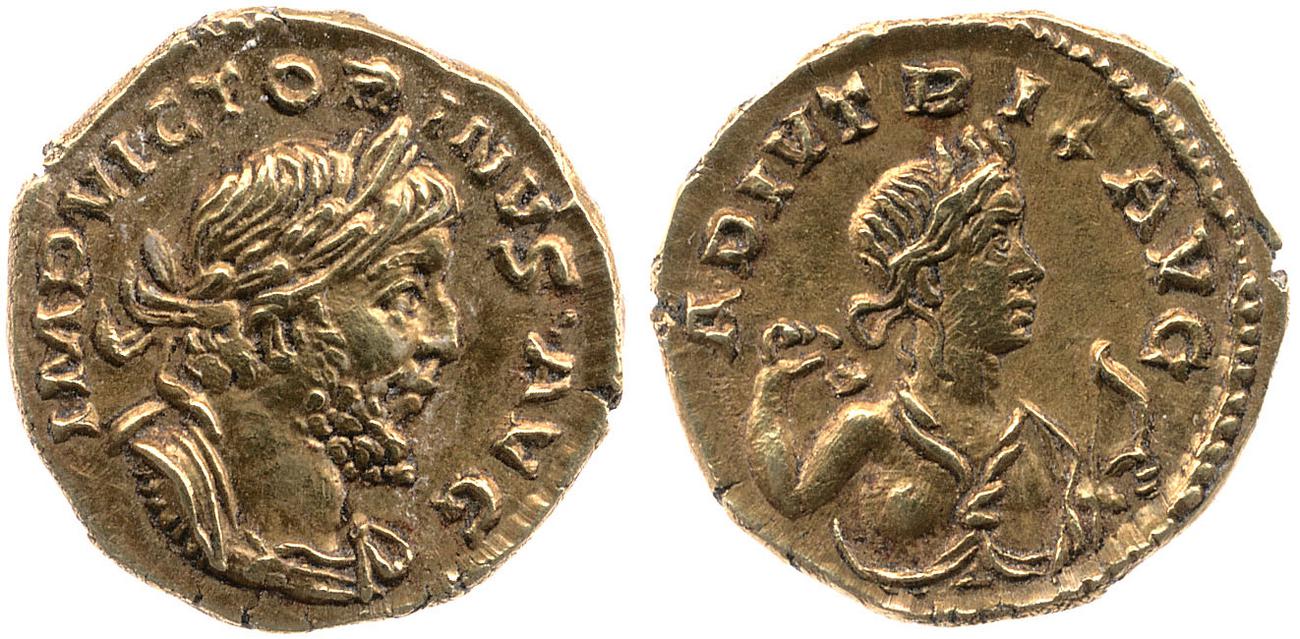Cologne (Victorinus), gold, quinarii (269-271 CE)
From SILVER
269 CE - 271 CE Gold 2,723 kg
Description
| ObverseInscription or printing placed on the obverse.: | Bust of Victorinus, laureate, cuirassed, right (Latin).IMP VICTORINVS AVG |
| ReverseInscription or printing placed on the reverse.: | Various legends. Here: ADIVTRIX AVG (Latin).Various types. Here: Bust of Diana, draped, right, holding bow in right hand and drawing arrow from quiver with left hand |
Mint and issuing power
| MintIdentifies the place of manufacture or issue of a numismatic object.: | Cologne | Ancient regionAncient region.: | Gallia | Modern countryModern country: | AuthorityIdentifies the issuing power. The authority can be "pretended" when the name or the portrait of X is on the coin but he/she was not the issuing power. It can also be "uncertain" when there is no mention of X on the coin but he/she was the issuing power according to the historical sources: | Roman Empire, Victorinus (269-271 CE) |
Chronology
| FromIdentifies the initial date in a range assigned in a numismatic context. | 269 CE | toIdentifies the final date in a range assigned in a numismatic context.. | 271 CE | PeriodTime period of the numismatic object.: Roman from 30 BC |
Physical description
| MetalThe physical material (usually metal) from which an object is made.: | Gold |
Median weightMedian of the weights of numismatic objects (in grams). in grams | 2.25 | DenominationTerm indicating the value of a numismatic object. Examples: tetradrachm, chalkous, denarius.: | quinarius | StandardStandard.: |
Image

Victorinus quinarii.jpg [1]
References
| Die study referencePublication of the study: | Schulte 19831Schulte 1983, p. 145-146, n° 1-3 | ||
| Coin series referenceReference to coin series study: | |||
Obverse dies distribution
| FrequencyFrequency of specimen in distribution. ᵖ | Number of obversesNumber of obverse dies. ᵖ (o) | % (o) | Number of coinsNumber of coins. (n) | % (n) | Die nameName(s) of the die(s). |
| 1 | 1 | 33.33 | 1 | 20 | 1 |
| 2 | 2 | 66.67 | 4 | 80 | 2, 3 |
| Total | 3 of 3 | 100 | 5 of 5 | 100 |
Reverse dies distribution
no distribution is available
Quantification
| Number of obversesNumber of obverse dies. ᵖ (o) | 3 | Number of singletons (o1)The number of singleton coins. ᵖ | 1 |
| Number of reverse diesNumber of reverse dies. (r) | 3 | Number of coinsNumber of coins. (n) | 5 |
| Coins per obverse dieNumber of coins per obverse die. (n/o) | 1.67 | Coins per reverse dieNumber of coins per reverse die. (n/r) | 1.67 |
| Reverse per obverse ratioRatio of obverse dies divided by reverse dies. (r/o) | 1 | Percentage of singletons (o1)number of coins (n) divided by the number of singletons (o1) ᵖ | 33.33 % |
| Original number of dies (O) (Carter 1983 formula)The estimation of the number of coins according to Carter 1983 ᵖ | 6.05 | Coins struck if 20,000 as average productivity per dieCoins made if the average productivity for obverses (according to Carter) is 20,000. ᵖ | 121,000 |
| Original number of dies (O) (Esty 2011 formula)The estimation of the number of coins according to the singleton formula in Esty 2011 ᵖ (O) | 7.5 | Survival rate if 20,000 as average productivity per dieSurvival rate if average productivity is 20,000. ᵖ | 0.00004 |
| Coverage (o = % of O) (Esty 1984 formula)Esty 1984 - coverage (% of O) ᵖ (o = % of O) | 80% | Die productivity if survival rate 1/2,000Average productivity if survival rate is 1/2,000. ᵖ | 1,652.89 |
| Weight of silver (in kg) if 20,000 coins per die (O = Carter formula)Carter 1983 * Median weight * 20000 (*10 if gold or electrum) ᵖ | 2,723 kg <br /> 2,723 kg | Die productivity if survival rate 1/5,000Average productivity if survival rate is 1/5,000. ᵖ | 4,132.23 |
Remarks
Most likely one single workstation Certainly military
References
- ^ Schulte, Bernhard (1983), Die Goldprägung der gallischen Kaiser von Postumus bis Tetricus, Typos. Monographien zur antiken Numismatik, IV, Aarau, Verlag Sauerländer, 189 p., 28 pl.